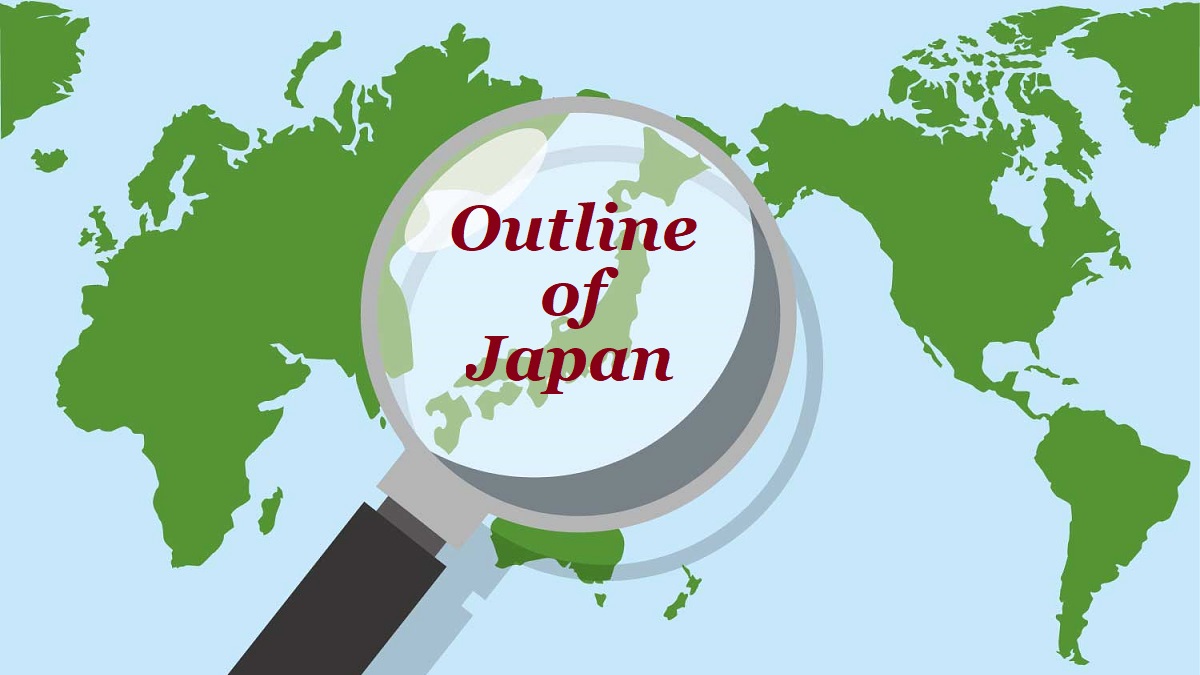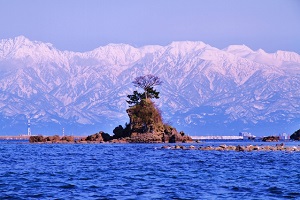Outline of Japan, the Emperor, Climate and History
Position of Japan on the earth
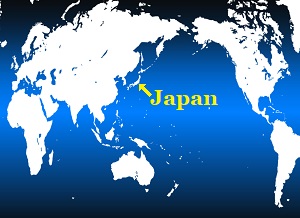
Position of Japan on the earth
Do you know the position of Japan on the earth?
As in the figure, Japan is located to the east of Eurasia Continent.
And, Japan is an island country surrounded by the sea.
Some say that the shape looks like "dragon" or "seahorse".
It is at the northwest edge of vast Pacific Ocean, so the position is just at the boundary of the world's largest continent and the world's vastest ocean.
Around Japan, there are South Korea, North Korea, China, Taiwan and Russia.
But Japan is far from the other countries.
Japan differs from China and Korea in many points
Probably, Western people can't distinguish Japanese from Chinese and Korean.
The face and body are certainly similar.
It is difficult for even Japanese to know that by appearance.
China and Korea are neighbor countries in northeast Asia.
But, each of Japan, China and Korea uses completely different language.
And each of them has different attitude, custom, manner and national character.
If you stay in Japan for some days, you may dimly understand Japanese people and society.
Please recognize Japan as a unique country.
Japan consists of 47 prefectures
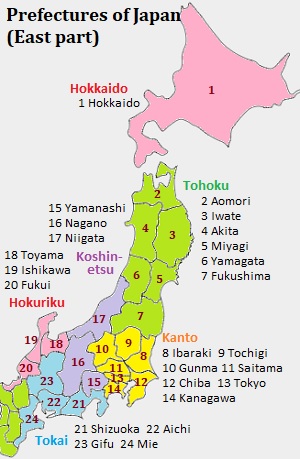
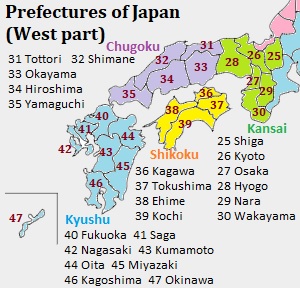
Japan consists of 47 prefectures.
Prefecture is a unit of local government under the nation.
A prefecture has some cities, towns and villages.
You need not be conscious of prefecture for your travel.
But each Japanese people has the consciousness that he/she was born and raised in the prefecture.
Each prefecture has a unique nature, history and dialect.
From them, unique culture, product and character are created.
Then, these become the proud of the prefecture for each person.
In this site, I introduce each prefecture and explain the tourist attractions as in the prefecture.
In addition, some prefectures are often grouped as a wide area.
In English, a word of "region" is applied to the group.
The combination to group the prefectures is almost fixed.
But there are a few different combinations in relation to mutual transportation and distribution.
When you travel around Japan within a limited period, "region" may be a good target to plan the travel.
In this site, I use the following regions.
Hokkaido, Tohoku, Kanto, Koshin-etsu, Hokuriku, Tokai, Kansai, Chugoku, Shikoku, and Kyushu
Hokkaido prefecture covers whole Hokkaido island and very wide.
So it is always a region.
The Emperor is the symbol of the state and of the unity of Japanese people
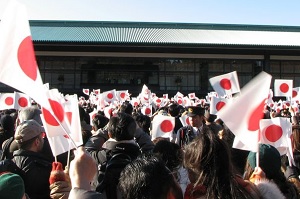
New Year Greeting of Imperial Family at the Imperial Palace
Ten-no is the Japanese word of "the Emperor of Japan".
It is never translated as "King".
It is said that the Westerners staying in Japan started using the word "emperor" for "Ten-no" in the 17th century.
Now, the head of the nation called as "Emperor" is only Ten-no of Japan in the world.
In fact, "Ten-no" may have slightly different meaning from "emperor" or "king".
Since the ancient time, Ten-no had been a head of Japan.
Now, Japan is in the reign of the 126th Ten-no.
His name is Naruhito without family name.
Japanese people commonly call him "Ten-no Heika" meaning "His Imperial Majesty the Emperor".
The Japanese emperor system has been hereditary completely.
The first Ten-no appeared in 660 B.C. and he founded Japan.
But that is not certain, and was described in Japanese mythology.
Currently, the 26th Ten-no can be identified with a real person, and he existed in the early 6th century.
Since that, Japanese Emperor family has succeeded to the Imperial Throne continuously for at least 1,500 years.
After Japan lost the World War II in 1945, the Alleys thought the abolition of Emperor system in Japan for the end of militarism nation.
But they were unable to ignore the Japanese mind that Ten-no had been the great spiritual support for all Japanese people.
Therefore, in new Constitution of Japan, it was provided that Ten-no was not an administrator but the symbol of the nation, and that was described as the first article in the Constitution.
The following is the article.
Article 1. The Emperor shall be the symbol of the State and of the unity of the people, deriving his position from the will of the people with whom resides sovereign power.
In addition, in the Constitution, it is provided that Ten-no can't take part in political affairs.
Apart from that, Ten-no has been very special to Japanese people.
Before the war, Ten-no had been the living God.
But now, Ten-no is emotional support for Japanese people.
Only Japanese people have such sensibility.
So, the Imperial Family are esteemed by Japanese people.
They are always invited to important national events and make a speech.
And, after great disasters such as earthquake and tsunami, they visit the disaster area and speak kind and encouraging words to the victims directly.
Japanese people are always watching the action with respect and thanks.
Japanese Era
In Japan, both Christian Era and Japanese Era are used as the representation of year.
Of course, you know Christian Era.
For example, the year of Tokyo Olympic Games is "2021 A.D."
The recent Japanese era names are as follows.
- Meiji (明治) : 1868 - 1912 (Meiji Ten-no)
- Taisho (大正) : 1912 - 1926 (Taisho Ten-no)
- Showa (昭和) : 1926 - 1989 (Showa Ten-no)
- Heisei (平成) : 1989 - 2019 (Heisei Ten-no)
- Reiwa (令和) : 2019 - now (Naruhito Ten-no)
For example, 2020 is the 2nd year of Reiwa.
And, as above, a Japanese era is the combination of two Kanji characters.
Since 645, Japanese era has been used for over 1,370 years.
Current "Reiwa" is the 248th name of Japanese era.
Era name had been used in the countries in eastern Asia such as China, Korea and Vietnam since the ancient times, but they abolished the system when their modern nations were formed after the end of their dynastic period in the early 20th century.
Therefore, only Japan is using era name in the world.
New Japanese Era starts from the year in which new Ten-no is enthroned.
The rule has been applied since "Meiji".
(Before that, each Emperor often changed the Japanese era when bad things had occurred in the country.)
When the Ten-no passed away or abdicated, new era started from the next day.
So, the first year of the new era is the same as the last year of the former era in most cases.
After that, the name of abdicated Ten-no is changed to his era name.
Therefore, Japanese era is directly linked to Japanese Emperor System.
Showa Ten-no passed away in the early morning on January 7, 1989.
The day became the last day in the 64th year of Showa.
The Japanese government announced that the new era was "Heisei" at 13:00 in the day.
For about four months until Showa Ten-no died, he had been serious ill.
Therefore, it is thought that Japanese government had considered the selection of new era name in secret.
From January 8, the date became the 1st year of Heisei.
Heisei Ten-no showed his intention to abdicate the throne due to old age in 2018.
So, Japanese government decided to pass the position of the Emperor to the Crown Prince.
Some authorities of Chinese and Japanese classics were assigned by the government, and they proposed new names.
These were considered by some experts, then the cabinet made a decision.
The Japanese government announced that the new era was "Reiwa" on April 1, 2019.
Then, Heisei Ten-no abdicated in the gratitude from all Japanese people on April 30, and Emperor Naruhito ascended the throne receiving a heartfelt welcome on May 1.
Now, we are in Reiwa era.
Nature and Climate in Japan
Japan is surrounded with seas.
It consist of four large islands and a lot of small islands.
And, a row of the islands shapes in an arc.
Over 70 percent of the land is mountainous, and most parts of that are covered with forests.
There is the mountain ranges of 3,000 meters class in the center part in the Honshu.
In Japan, there are 111 active volcanos. It is 7% of all volcanos in the world.
Mt.Fuji is also an active volcano.
So there are a lot of hot springs throughout the country. More than 3,000 of them have any facility as hot spring resorts.
The widest part of the land is within only 300 kilometers.
Because there are high mountain ranges in the center, most rivers are short and have rapid streams.
So, a lot of valleys, gorges and waterfalls are in the whole country.
Such nature in Japan creates many popular tourist attractions.
And it also creates unique climate of Japan.
Japan mainly belongs to the temperate zone.
But, the north part such as Hokkaido belongs to the subarctic zone, and the south part such as Okinawa Islands belongs to subtropics.
In addition, there is extensive continent to the west and there is Sea of Japan between it and Japan.
And there is vast ocean to the east and south.
This situation moves the various air masses around Japan, so unique four seasons in Japan are created.
I introduce the details of the climate in Japan in the following page.
History in Japan
Japan has a history of over two thousand years.
Japan has never been occupied by any other country, and has existed until now.
Probably, the reason is that Japan was a remote island nation in the Far East.
Since the ancient time, the leading role in the history has been the Emperor (Ten-no).
Ancient Japan learned many things from ancient China, then created the own nation.
In the middle years, samurai governed the country as the substitute of the Emperor. Of course, the power struggle sometimes occured.
In the 19th century, they learned modern nation from the Western countries, then they changed from a feudal nation to a modern industrialized nation earlier than other Asian nations.
But, in the early 20th century, Japan ran its course toward the War since the Great Depression.
By two atomic bombs, Japan defeated in 1945.
Destroyed Japan revived, developed, and became the Japan of today.
Above story is too rough.
If you want to know a little detailed history of Japan, please read the following page.
Various Data about Japan
| Name of the Country | Japan (in English) Nihon or Nippon (in Japanese. Both are used.) [It is written "日本" in kanji (Chinese charcters).] |
| Capital | Tokyo |
| Population | 123 million (2025) |
| Area of land | About 378,000 km² |
| Official Languge | Japanese |
| National Flag | Hinomaru ("Nisshoki" in formal) |
| National Flower (not legislating) | Sakura (Cherry blossom) [General national flower] 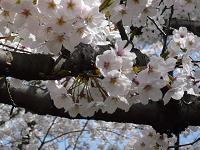 Kiku (Chrysanthemum) [Flower of Imperial House] 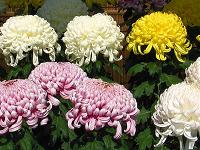 |

